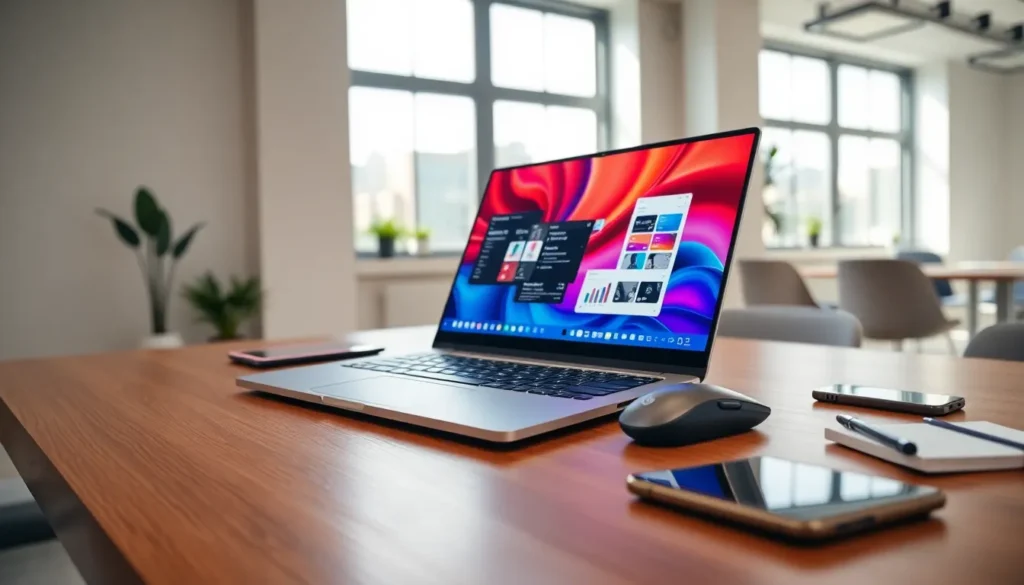Table of Contents
ToggleIn a world where laptops have become our constant companions, it’s easy to forget that they can also be the architects of our discomfort. Picture this: hunched over like a question mark, fingers flying across the keyboard, and that nagging back pain creeping in like an unwanted house guest. It’s time to take a stand—or rather, a seat—because ergonomics isn’t just a fancy word for “how to sit pretty.” It’s the secret sauce to staying comfortable and productive.
Arming oneself with ergonomic knowledge can transform a laptop user’s experience from a back-breaking ordeal to a blissful journey. With the right adjustments, anyone can fend off the aches and pains that come with long hours of screen time. So grab your favorite coffee, sit back, and discover how to turn that laptop into a throne of productivity without sacrificing comfort.
Understanding Ergonomics for Laptop Users
Ergonomics plays a critical role in ensuring comfort and health for laptop users. Proper ergonomic practices transform how users interact with their devices, leading to heightened productivity.
Definition of Ergonomics
Ergonomics refers to the science of designing workspaces and tools to fit the user’s needs. This discipline aims to enhance efficiency while reducing discomfort, focusing on posture, repetition, and the physical environment. It involves adjusting the height of screens, the position of keyboards, and other factors to promote a natural and pain-free workflow. Studies confirm that ergonomic setups decrease physical strain, leading to a more productive experience.
Importance of Ergonomics for Laptop Users
Prioritizing ergonomics holds significant benefits for laptop users. Improved posture decreases the likelihood of musculoskeletal disorders like back pain and neck strain. Adjusting the workspace can foster better concentration and reduce fatigue during long work sessions. Research indicates that users who implement ergonomic principles experience increased comfort in their daily activities. Investing time in setting up an ergonomic workspace ultimately enhances overall well-being and productivity.
Common Posture Issues
Laptop users often encounter various posture-related issues. Understanding these problems can lead to effective solutions.
Neck and Shoulder Strain
Neck and shoulder strain commonly affects laptop users. Poor monitor height forces users to bend their necks, causing discomfort over time. Elevated shoulder tension can result from inadequate seating arrangements. Users frequently slouch, leading to awkward angles that strain muscles. Maintaining an aligned position aids in reducing strain. Adjusting the screen height to eye level minimizes neck flexion. Using ergonomic chairs can further support proper posture. Utilizing a headset instead of cradling a phone aids in alleviating shoulder stress.
Wrist and Hand Discomfort
Wrist and hand discomfort is prevalent among those who spend long hours on laptops. Often, users type with their wrists bent at unnatural angles. This position creates strain on the tendons and can result in conditions like carpal tunnel syndrome. Keeping wrists straight while typing is crucial for preventing pain. Ergonomic keyboards and wrist rests provide necessary support and comfort. Adjusting the height of the laptop or using a separate keyboard helps maintain neutral wrist positioning. Regular breaks to stretch fingers and wrists enhance circulation and reduce discomfort. Implementing these changes can significantly alleviate symptoms.
Best Practices for Ergonomic Setup
Creating an ergonomic setup enhances comfort and productivity for laptop users. Adhering to best practices helps prevent discomfort and long-term strain.
Ideal Laptop Height and Position
Position the laptop screen at eye level to avoid neck strain. Users should maintain a viewing distance of about 20 to 30 inches. Adjusting the angle of the screen eliminates glare and enhances visibility. Feet must rest flat on the ground or a footrest for proper posture support. Keeping the shoulders relaxed and arms at a 90-degree angle while typing aids in reducing shoulder strain. Regular checks on posture throughout the day ensure adjustments are made as needed.
Using External Accessories
External accessories, such as keyboards and mice, significantly improve ergonomics. Ergonomic keyboards encourage natural wrist positioning, reducing strain during typing. A mouse placed at elbow height minimizes wrist strain during use. A laptop stand raises the screen to an appropriate height, alleviating neck discomfort. Wrist rests provide cushioning and support while typing, promoting better hand alignment. Incorporating an external monitor can enhance screen real estate, further supporting eye health and productivity.
Tips for Reducing Fatigue
Reducing fatigue enhances comfort and productivity for laptop users. Simple adjustments and practices can make a significant difference.
Regular Breaks and Stretching
Incorporating regular breaks offers essential relief from prolonged laptop use. Schedule breaks every 30 to 60 minutes to stand up and walk around. Stretching during these intervals improves circulation and alleviates tension. Focus on stretches for the neck, shoulders, and wrists to counteract stiffness. Engaging in quick physical activity, like a short walk or gentle yoga, also refreshes the mind. Research shows that users who prioritize breaks experience less fatigue and improved focus during work sessions.
Adjusting Your Workspace
Optimizing the workspace drastically reduces physical strain. Adjust the laptop screen to eye level to prevent neck strain. Position the screen 20 to 30 inches from the eyes to support comfortable viewing. Ensure the chair provides adequate back support, keeping feet flat on the ground or on a footrest. Arm positioning matters too; maintaining a 90-degree angle while typing helps prevent discomfort. Using external accessories like ergonomic keyboards and mice further enhances wrist positioning. A laptop stand elevates the screen, promoting better posture. These adjustments lead to a healthier, more ergonomic laptop experience.
Conclusion
Prioritizing ergonomics is essential for laptop users aiming to enhance their comfort and productivity. By making simple adjustments to their workspace and posture, individuals can significantly reduce the risk of discomfort and long-term health issues. Implementing practices like maintaining an appropriate screen height and using ergonomic accessories can create a more supportive environment.
Regular breaks and stretches are vital in combating fatigue and maintaining focus throughout the day. Ultimately, adopting ergonomic principles transforms the laptop experience into one that’s not only more enjoyable but also healthier. By taking these steps, users can ensure they work efficiently without sacrificing their well-being.




